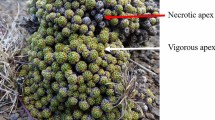Abstract
The geographic distributions ofCastanopsis sieboldii andCastanopsis cuspidata overlap each other on the Pacific coast of Japan, but on the Japan Sea coastC. sieboldii tends to dominate at similar temperatures. The authors attempted to explain this phenomenon by analyzing the effects of climatic factors. Nuts were collected from the Pacific and Japan Sea coasts of the Kinki and Chugoku districts, and the nut characteristics and the number of layers of epidermis in the leaves of the seedlings were investigated. The distribution ofC. sieboldii andC. cuspidata was satisfactorily explained by a multiple regression equation that was developed using three climatic factors: maximum snow depth in winter, lowest temperature in the coldest month, and annual mean temperature, out of fourteen such factors that were considered. The estimated distribution ofC. sieboldii andC. cuspidata from the multiple regression equation agreed with 66.2% of the actual observations.
Similar content being viewed by others
Literature cited
Environmental Agency (1988a) Important plant communities in Japan II, Hokuriku. 651pp, Printing Bureau, Ministry of Finance, Tokyo. (in Japanese)
Environmental Agency (1988b) Important plant communities in Japan II, Kinki 1. 428pp, Printing Bureau, Ministry of Finance, Tokyo. (in Japanese)
Environmental Agency (1988c) Important plant communities in Japan II, Kinki 2. 418pp, Printing Bureau, Ministry of Finance, Tokyo. (in Japanese)
Environmental Agency (1988d) Important plant communities in Japan II, Chugoku 1. 609pp, Printing Bureau, Ministry of Finance, Tokyo. (in Japanese)
Environmental Agency (1988e) Important plant communities in Japan II, Chugoku 2. 601pp, Printing Bureau, Ministry of Finance, Tokyo. (in Japanese)
Hagiwara, S. (1977) A cline on leaf size ofFagus crenata. Shuseibutugaku-kenkyu 1: 39–51. (in Japanese)
Hattori, T., Nakanishi, S., and Takeda, Y. (1987) The chorological study of the main Lucidophyllous species in the Kinki district with special reference to their immigration during the postglacial period. Jpn. J. Ecol. 37: 1–10. (in Japanese with English summary)
Hiroki, S. and Ichino, K. (1991) The distribution ofCastanopsis cuspidata and its allies examined from a viewpoint of fruit shape. J. Phytogeogr. Taxon. 39: 79–86. (in Japanese with English summary)
Hiura, T. (1996) Geographic variation and maintenance of species diversity of beech forest in Japan. Jpn. J. Ecol. 46: 175–178. (in Japanese)
Hotta, M. (1974) History and geography of plants. Evolutionary biology in plants III. 400pp, Sanseido, Tokyo. (in Japanese)
Japan Meteorological Agency (1996) Meteorological mean values of Japan. CD-ROM. Japan Meteorological Business Support Center, Tokyo. (in Japanese)
Kira, T. (1949) Forest zones of Japan. 42pp, Ringyo Gijutsu Kyokai, Tokyo. (in Japanese)
Kobayashi, Y. and Sugawa, T. (1959) Identification of wood of someCastanopsis species in Japan. Bull. Gov. For. Exp. Stat. 118: 139–178. (in Japanese with English summary)
Kure, H. and Yoda, K. (1984) The effects of the Japan Sea climate on the abnormal distribution of Japanese beech forest. Jpn. J. Ecol. 34: 63–73.
Maeda, T. (1980) Sea and forests in Jomon Period. 238pp, Soju-Shobo, Tokyo. (in Japanese)
Martonne, M.E. (1926) Areisme et indice d’aritile. Compt. Rend. Acad. Sci. 182: 1395–1398.
National Land Agency (1998) Digital national land information, G01-56M. National Land Agency, Tokyo. (in Japanese)
Shimano, K. (1998) What prevents beech (Fagus crenata) from regenerating in Pacific ocean type beech forest? J. Phytogeogr. Taxon. 46: 1–21. (in Japanese with English summary)
Suzuki, T. and Suzuki, K. (1971) Der index des Japanischen meers und der Setouti-index. Jpn. J. Ecol. 20: 252–255. (in Japanese with German summary)
Tomaru, N., Mitsutsuji, T., Takahashi, M., Tsumura, Y., Uchida, K., and Ohba, K. (1997) Genetic diversity inFagus crenata (Japanese beech): Influence of the distributional shift during the late-Quaternary. Heredity 78: 241–251.
Tomaru, N., Takahashi, M., Tsumura, Y., Takahashi, M., and Ohba, K. (1998) Intraspecific variation and phylogeographic pattern ofFagus crenata (Fagaceae) mitochondrial DNA. Am. J. Bot. 85: 629–636.
Yamada, H. and Handa, T. (1994) Genetic variation inCastanopsis cuspidata andC. cuspidata var.sieboldii (I) Variation of seed characters in and around Okayama Prefecture. Trans. Jpn. For. Soc. 105: 351–352. (in Japanese)
Yamada, H. and Handa, T. (1995) Genetic variation inCastanopsis cuspidata andC. cuspidata var.sieboldii (II) Variation in leaf epidermal tissue ofCastanopsis families. Trans. Jpn. For. Soc. 106: 271–272. (in Japanese)
Yamada, H. and Nishimura, K. (2000) Geographical distributions ofCastanopsis sieboldii andC. cuspidata in and around Okayama Prefecture, Japan. J. Jpn. For. Soc. 82: 101–104. (in Japanese with English abstract)
Yamanaka, T. (1966) Problems ofCastanopsis cuspidata Schottky. Bull. Fac. Educ. Kochi Univ. 18: 65–73. (in Japanese)
Yamanaka, T. (1979) Forest vegetation in Japan. 219pp, Tsukiji-Shokan, Tokyo. (in Japanese)
Yamazaki, H. and Mashiba, S. (1987) A taxonomical revision ofCastanopsis cuspidata (Thunb.) Schottky and the allies in Japan and Taiwan (1). J. Jpn. Bot. 62: 289–298. (in Japanese)
Yoshioka, K. (1954) Sociological studies of the forests in the Tohoku District 4. Forest communities in the northern limits ofShiia sieboldii. Bull. Soc. Plant Ecol. 3: 219–229. (in Japanese with English summary)
Author information
Authors and Affiliations
Corresponding author
About this article
Cite this article
Yamada, H., Yamaguchi, K. & Miyaura, T. Effect of Japan Sea climate on geographic distribution ofCastanopsis sieboldii andC. cuspidata . J For Res 7, 67–71 (2002). https://doi.org/10.1007/BF02762510
Received:
Accepted:
Issue Date:
DOI: https://doi.org/10.1007/BF02762510




